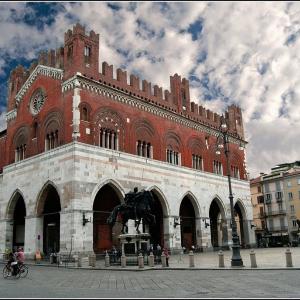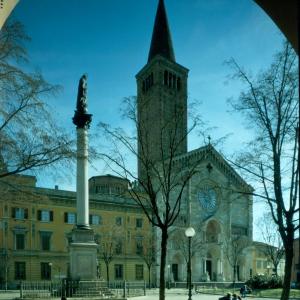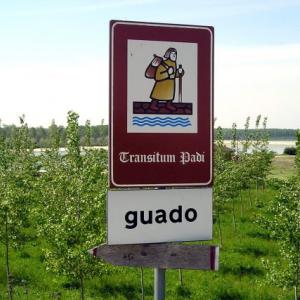THE VIA FRANCIGENA IN PIACENZA
Piacenza and its province are at the crossroads between four regions (Piedmont, Lombardy, Liguria, Emilia Romagna) and a place of passage of historical routes and pilgrims.
Sigeric, the Archbishop of Canterbury, crossed the Po river at Calendasco (Piacenza) in 990 AD, on his return journey from Rome where he had received his investiture from the Pope. What is even more remarkable is that Calendasco was the location of the ancient Roman river port of Piacenza (historical sources cite an emporium, which is to be expected at a port where goods arrived). The Via Francigena is mentioned in papers of 1140, 1187 and 1056, where we find a reference to the "Rome route" going through "in eodem loco Kalendasco".
At the port of Calendasco, boats had to pay a tax for mooring or just to pass through towards Venice or Pavia. The crossing locality is Soprarivo (Super rivum), and nowadays it is equipped with a landing stage for pilgrims and tourists, and has been recognized since 1994 by the Council of Europe, and since 2009 by the two Italian Ministries, as the official Transitus Padi (crossing of the Po river).
An agreement between the people of Piacenza and Ferrara signed on November 5, 1181 reports: «[...] et Ferrariensis debe esse salvus et custoditus in persona et in habere in Placentia et in districtu Placentie, et non debet dare aliquam dationem in Placentia vel in districtu Placentie, nisi duos solidos de fune navis et unam libram piperis super rivum et unam aliam libram piperis ad roncarolum de sterio [...]».
The Longobard King Liutprand asserted his privileges to this port with a document of 715 and Charlemagne reaffirmed them for three important reasons: the importance of the Roman consular road Placentia-Ticinum, the river port with its collection of taxes, and the presence of the castle and its buildings which acted as outposts near the city.
It is thought that Sigeric arrived from Piacenza on the Via Francigena that in this stretch followed the Placentia – Ticinum (Piacenza-Pavia) Roman road and, like so many other medieval pilgrims, merchants and travellers, crossed the Po at the port of Calendasco. Here the pilgrims would rest at the ancient Franciscan hospice. The Municipality of Calendasco, at the outskirts of Piacenza, is part of the "European Association of Francigena Ways" and is widely cited in historical documents concerning the crossing the Po river in the Via Francigena "Scientific Dossier" commissioned by the Council of Europe for the 2000 Jubilee. Today the Municipality of Calendasco can offer pilgrims and tourists the service of two river moorings.
The imposing and magnificent Farnese Palace is the symbol of the city of Piacenza. It is the seat of the Civic Museums and Art Gallery, holds exhibits about the Middle Ages, the Renaissance, weapons, carriages, glass and ceramics, the Risorgimento and has an archaeological section.
After admiring the Palace we walk along via Cittadella towards Piazza Cavalli (Square of the Horses), which takes its name from the baroque equestrian statues of the Farnese dukes, and which is overlooked by the majestic Gothic palace.
We reach Piazza Duomo and the Romanesque Cathedral with the gold-plated copper angel on top of the bell tower. Walking on among ancient palaces, Romanesque churches and small shops, we reach the Ricci Oddi Gallery, one of the most important Italian collections of modern art.

 View Interactive Map
View Interactive Map










